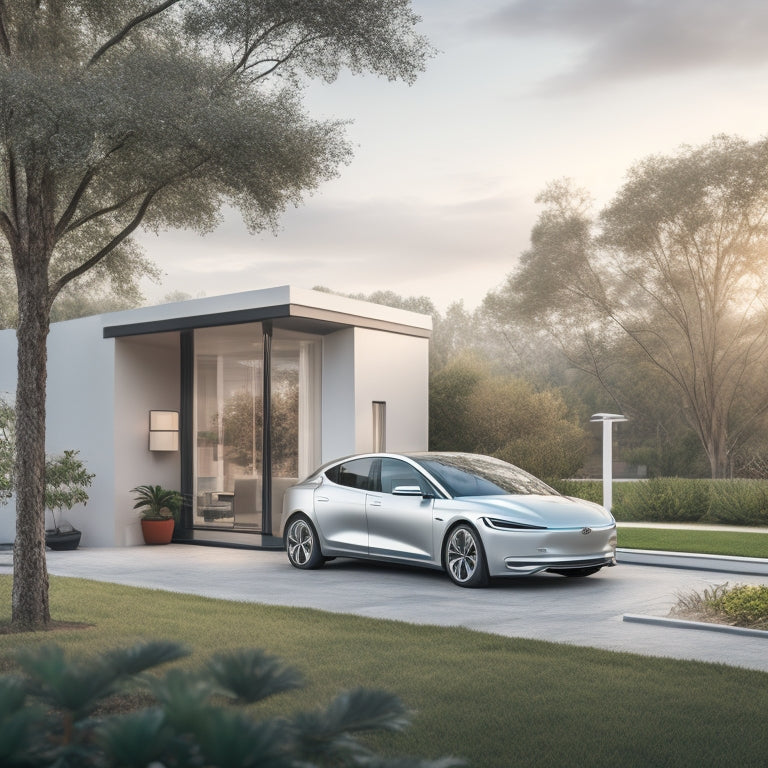
Mastering Electric Car Charging: A Comprehensive Guide
Share
Mastering electric car charging requires a thorough understanding of the different charging methods, convenient access to charging stations, and optimized charging habits to guarantee efficient electric vehicle ownership. Level 1, Level 2, and Quick Charging methods each have their advantages and disadvantages, and grasping charging etiquette is essential. Developing ideal charging habits, such as charging during off-peak hours and topping off whenever possible, can improve efficiency, reduce energy costs, and prolong battery life. A holistic approach to electric car charging can alleviate range anxiety and optimize the overall electric vehicle experience, and exploring each of these key aspects in detail can reveal even more insights.
Key Takeaways
• Understanding different charging methods (Level 1, Level 2, and Quick Charging) is crucial for efficient electric vehicle ownership.
• Locating convenient and accessible charging stations is essential for EV owners, with public networks and online resources available to help.
• Developing ideal charging habits aligned with daily routines can improve efficiency, reduce energy costs, and prolong battery life.
• Charging during off-peak hours and topping off the charge whenever possible can reduce energy costs and range anxiety.
• Scheduled charging can optimize energy efficiency and convenience, allowing EV owners to master their charging habits.
Understanding Charging Methods
When it comes to charging an electric vehicle, there are three primary methods worth exploring, each with its own advantages and disadvantages: Level 1, Level 2, and Quick Charging.
Level 1 charging utilizes a standard household outlet, providing a slow but convenient charging method ideal for home use.
Level 2 charging, on the other hand, operates at a higher voltage, reducing charging time to 4-8 hours, making it suitable for public charging stations.
Quick Charging, the fastest method, uses high-voltage direct current (DC) to rapidly replenish the battery, ideal for long road trips.
Understanding these different charging methods and their corresponding voltages is essential for efficient and convenient electric vehicle ownership, whether charging at home or in public.
Finding Charging Stations
One of the most significant considerations for electric vehicle owners is locating convenient and accessible charging stations, particularly in metropolitan areas where they are more abundant.
To guarantee a seamless charging experience, it is crucial to understand charging etiquette, such as prioritizing emergency charging and respecting time limits at public stations.
Alternative charging solutions, like home charging, can also be explored.
Public charging options, including networks like EVgo, Electrify America, and ChargePoint, offer a growing number of stations.
Utilizing online resources and mobile apps can help locate charging stations, while some EVs even have built-in navigation systems that provide this information.
Optimizing Charging Habits
To maximize the efficiency and convenience of electric vehicle ownership, it is essential to develop ideal charging habits that align with daily routines and minimize range anxiety. By adopting best charging habits, owners can improve charging efficiency, reduce energy costs, and prolong battery longevity.
For instance, charging during off-peak hours or using scheduled charging can reduce energy costs and alleviate strain on the electrical grid. Additionally, topping off the charge whenever possible can reduce range anxiety and guarantee a full battery when needed.
Frequently Asked Questions
Can I Charge My Electric Vehicle in the Rain or Snow?
During a torrential downpour, Sarah safely charged her electric vehicle using a weatherproof charger, ensuring rainy day safety. Yes, you can charge your electric vehicle in the rain or snow, thanks to weather-resistant charging stations and built-in safety features.
How Far Can I Drive on a Single Charge on Average?
On average, electric vehicles can drive between 200-300 miles on a single charge, depending on factors like terrain, climate, and driving habits. Range anxiety can be mitigated by understanding battery health and optimizing charging routines to guarantee peak performance.
What Happens if I Accidentally Unplug My Car While Charging?
"Avoid the anxiety-inducing scenario of accidentally unplugging your electric vehicle while charging by adhering to safety precautions, such as ensuring a secure connection and monitoring the charging process to prevent disruptions."
Do Electric Vehicles Have a Limited Number of Charging Cycles?
Electric vehicles' batteries are designed to withstand numerous charging cycles, typically between 300 to 500, without significant degradation, ensuring peak battery health and performance, with minimal capacity loss over time.
Can I Charge My Electric Vehicle Using a Generator?
'As the wheels of innovation turn, a beacon of freedom from grid reliance emerges. Yes, you can charge your electric vehicle using a generator, but prioritize Generator Safety and guarantee compatibility for seamless Off Grid Charging, where adventure meets sustainability.'
Related Posts
-

Why Solar HVAC Filters Revolutionize Home Energy Efficiency
By adopting solar HVAC filters, you're shifting your home's energy reliance from fossil fuels to clean, renewable sou...
-

Why Choose Cool Roofs in Scorching Climates?
You opt for cool roofs in scorching climates because they enable you to reclaim control over your energy consumption ...
-

Why Merge Earth's Heat With Sun's Energy?
You're about to utilize the full potential of renewable energy by combining the Earth's natural heat with the Sun's a...


